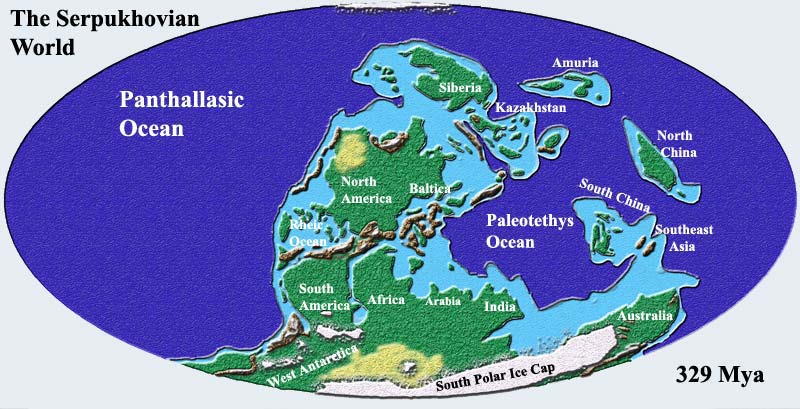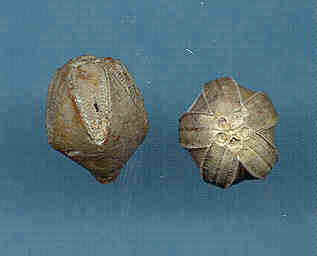
| Palaeos: Paleozoic |  |
Mississippian Epoch |
| Carboniferous Period | Serpukhovian Age |
| Page Back | Back: Viséan | Back: Late Devonian | Up: Mississippian | Unit Home |
| Page Next | Next: Bashkirian | Next: Pennsylvanian | Timescale |
The Serpukhovian is the last of the three ages that make up the Mississippian Epoch. This is the Age from which come the remarkable tetrapods of East Kirkton and the Dora Bone Beds, as well as the wonderful chondrichthyan fauna of Bear Creek. This Age saw the appearance and rapid diversification of of winged insects, "typical" Paleozoic tetrapods, proto-amniotes, and the great Coal Swamp forests.
Sea levels were moderate throughout the Carboniferous. The seas rose steadily through most of the Sepukhovian, but fell rather sharply at the end of the Age, coincident with the onset of icehouse conditions and the beginnings of the Pennsylvanian Ice Age. Grossman et al. (2002); Mii et al. (2001). At about this same time, the connection between the Rheic and Paleotethys Oceans closed as Gondwana met and sutured to Laurussia (North America plus Baltica) to form Pangaea. This resulted in partial thermal isolation of the Paleotethys, which became a great semi-tropical bay. The climate, which had been fairly equable throughout most of the Mississippian, became more strongly zonal. Interestingly, these dramatic climate changes in the Late Serpukhovian occurred at just about the same time as the major evolutionary events of the Age: the sudden spread of winged insects, the evolution of protoamniotes (e.g., Embolomeri), and a rapid turnover in brachiopod genera.
ATW041224. Public domain. No rights reserved.

ATW041219. Map public domain. No rights reserved. An enormous, 2400 x 1200 pixel, unlabelled version of this map is available (free) in all the usual formats, including a Photoshop® .psd file with each topographical type on a different layer. That one is 13 MB. Email augwhite@sbcglobal.net.
The following table correlates strata with tetrapod fossils (amphibians):
| approx time * |
N o
|
r t h |
A m e r
|
i c a |
|
||
| Location
(present geography) |
Age | Utah | Iowa | West Virginia | Nova Scotia | Scotland
Midland Valley |
|
| Alportian | 324 | ||||||
| Serpukhovian | Chokierian | 326
328 |
|||||
| Arnsbergian | 330 | ||||||
| Pendleian | 332 | Manning Canyon Shale | Dora Bone Bed, Crowdenbeath, Fife |
|
The small shark Falcatus falcatus, from the Bear Gulch limestone of Montana. Photo by H. Zell - Wikipedia |
The Dora lagerstätten of East Kirkton, Scotland (late Visean or possibly Earliest Serpukhovian), stands out as a unique glimpse of Middle Carboniferous vertebrates. The somewhat later Bear Gulch locality in Montana (Late Serpukhovian or possibly Bashkirian) provides an important glimpse of Carboniferous fish life.

The Blastoid echinoderm Pentremites godoni |
Goniatites suffer a mass extinction but a few lineages continue onto the following Bashkirian epoch.
| Page Back | Unit Home | Page Up | Page Top | Page Next |